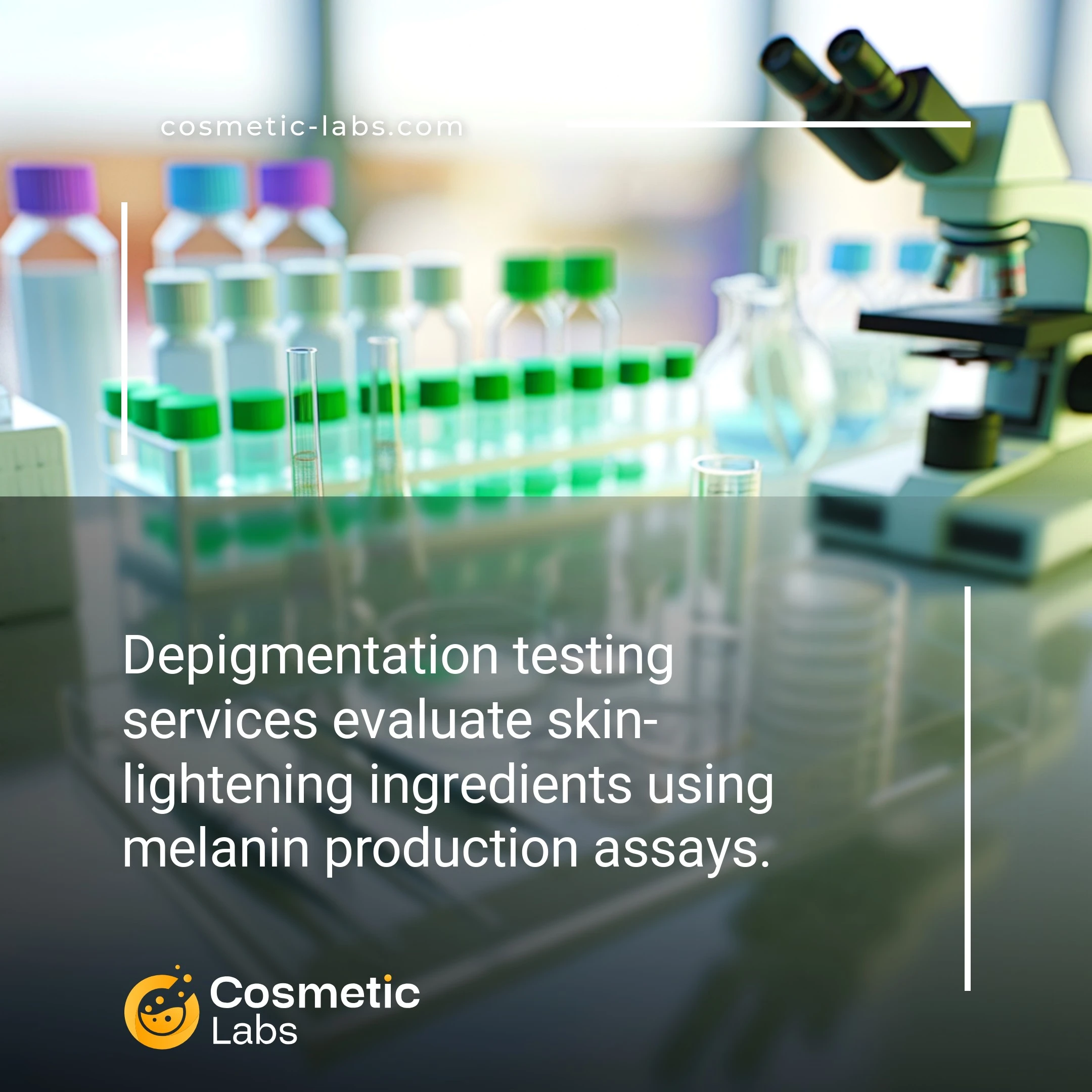Depigmentation Testing Services for Cosmetic Products

What is Depigmentation testing?
Depigmentation testing services evaluate how effectively cosmetic ingredients and formulations reduce melanin production or lighten existing dark spots through controlled in vitro and ex vivo assays. Labs measure tyrosinase inhibition activity, melanin synthesis reduction, and skin brightening effects using standardized protocols like the mushroom tyrosinase assay and 3D skin models. What many brands don’t realize is that these tests can predict ingredient efficacy at concentrations as low as 0.1%, helping you optimize formulations before costly clinical trials.
Why do you need this service?
Cosmetic brands use depigmentation testing services to validate brightening serums and dark spot treatments before market launch, measuring melanin reduction rates in controlled lab environments. These tests help you optimize active ingredient concentrations in vitamin C formulations, kojic acid treatments, and hydroquinone alternatives, delivering quantifiable proof of efficacy that supports marketing claims and regulatory submissions across global markets.
Who provides Depigmentation testing services?
All cosmetic labs providing Depigmentation testing services
There is no company providing these services at the moment.
Depigmentation Testing Services
Depigmentation testing services validate your skin-lightening formulations through controlled laboratory assessments that measure melanin reduction and skin tone improvement. These specialized tests complement pigmentation efficacy studies by focusing specifically on products designed to fade dark spots, even skin tone, and reduce hyperpigmentation.
In Vitro Melanin Inhibition Testing
Labs use cultured melanocytes to test how effectively your ingredients block melanin production at the cellular level. This approach screens active compounds like kojic acid, arbutin, and vitamin C derivatives before moving to human trials.
Key testing protocols include:
- Tyrosinase enzyme inhibition assays
- Melanin content quantification
- Cell viability assessments
- Dose-response curve analysis
Results provide concentration guidelines for your formulation and help predict clinical efficacy before costly human studies.
Clinical Depigmentation Studies
Human volunteer studies measure actual skin lightening effects using standardized protocols and objective measurement tools. Labs recruit participants with specific pigmentation concerns and track changes over 4-12 week periods.
Testing methods include:
- Chromameter readings for L*a*b* color space analysis
- Digital photography with consistent lighting
- Mexameter measurements for melanin index
- Subject self-assessment questionnaires
These studies generate the clinical data needed for marketing claims and regulatory submissions. Connect with experienced labs on our platform to design depigmentation studies that meet your specific product goals and target market requirements.
Practical Applications of Depigmentation Testing Services
Cosmetic labs use depigmentation testing services to validate skin-lightening claims across whitening creams, dark spot correctors, and anti-aging formulations before market launch.
Whitening Product Development and Claims Validation
Labs conduct melanin inhibition assays using tyrosinase enzyme studies to measure active ingredient potency in brightening serums and spot treatments. These tests determine optimal concentrations for kojic acid, arbutin, and vitamin C derivatives within 2-4 weeks of testing.
Product developers rely on standardized melanogenesis protocols to compare formulation effectiveness against established benchmarks. Labs measure melanin reduction percentages, helping brands substantiate “visible lightening in 28 days” claims with quantifiable data.
Hyperpigmentation Treatment Efficacy Assessment
Testing services evaluate melasma and age spot treatments through controlled cell culture models that simulate UV-induced pigmentation. Labs expose melanocyte cultures to specific wavelengths, then measure depigmentation response to active compounds.
Formulators use these results to optimize hydroquinone alternatives and natural extracts like licorice root or niacinamide. The testing identifies minimum effective concentrations while screening for cytotoxicity, ensuring both safety and efficacy in final products.
| Testing Method | Timeline | Key Measurement | Best For |
|---|---|---|---|
| Tyrosinase Inhibition | 3-5 days | Enzyme activity % | Ingredient screening |
| Melanocyte Culture | 7-14 days | Melanin content | Formula optimization |
| 3D Skin Models | 14-21 days | Pigmentation intensity | Finished product validation |
Ready to validate your depigmentation claims? Contact qualified labs on our platform to discuss your specific testing requirements and timeline.
